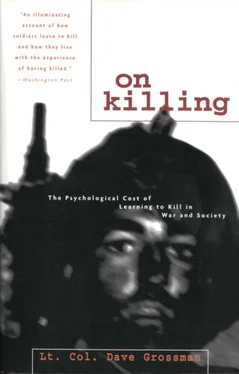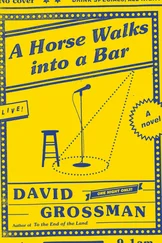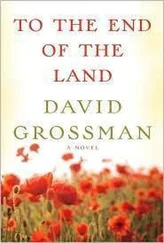Sometimes the fire was completely harmless, as Benjamin McIntyre observed in his firsthand account of a totally bloodless nighttime firefight at Vicksburg in 1863. “It seems strange…,” wrote McIntyre, “that a company of men can fire volley after volley at a like number of men at not over a distance of fifteen steps and not cause a single casualty. Yet such was the facts in this instance.” The musketry of the black-powder era was not always so ineffective, but over and over again the average comes out to only one or two men hit per minute with musketry.
(Cannon fire, like machine-gun fire in World War II, is an entirely different matter, sometimes accounting for more than 50 percent of the casualties on the black-powder battlefield, and artillery fire has consistently accounted for the majority of combat casualties in this century. This is largely due to the group processes at work in a cannon, machine-gun, or other crew-served-weapons firing. This subject is addressed in detail later in this book in the section entitled “An Anatomy of Killing.”)
Muzzle-loading muskets could fire from one to five shots per minute, depending on the skill of the operator and the state of the weapon. With a potential hit rate of well over 50 percent at the average combat ranges of this era, the killing rate should have been hundreds per minute, instead of one or two. The weak link between the killing potential and the killing capability of these units was the soldier. The simple fact is that when faced with a living, breathing opponent instead of a target, a significant majority of the soldiers revert to a posturing mode in which they fire over their enemy’s heads.
Richard Holmes, in his superb book Acts of War, examines the hit rates of soldiers in a variety of historical battles. At Rorkes Drift in 1897 a small group of British soldiers were surrounded and vastly outnumbered by the Zulu. Firing volley after volley into the massed enemy ranks at point-blank range, it seems as if no round could have possibly missed, and even a 50 percent hit rate would seem to be low. But Holmes estimates that in actuality approximately thirteen rounds were fired for each hit.
In the same way, General Crook’s men fired 25,000 rounds at Rosebud Creek on June 16, 1876, causing 99 casualties among the Indians, or 252 rounds per hit. And in the French defense from fortified positions during the Battle of Wissembourg, in 1870, the French, shooting at German soldiers advancing across open fields, fired 48,000 rounds to hit 404 Germans, for a hit ratio of 1 hit per 119 rounds fired. (And some, or possibly even the majority, of the casualties had to have been from artillery fire, which makes the French killing rate even more remarkable.)
Lieutenant George Roupell encountered this same phenomenon while commanding a British platoon in World War I. He stated that the only way he could stop his men from firing into the air was to draw his sword and walk down the trench, “beating the men on the backside and, as I got their attention, telling them to fire low.” And the trend can be found in the firefights of Vietnam, when more than fifty thousand bullets were fired for every enemy soldier killed. [4] The universal distribution of automatic weapons is probably responsible for much of this large number of shots fired per kill. Much of this firing was also suppressive fire and reconnaissance by fire. And much of it was by crew-served weapons (e.g., squad machine guns, helicopter door gunners, and aircraft-mounted miniguns firing thousands of rounds per minute), which, as mentioned before, almost always fire. But even when these factors are taken into consideration, the fact that so much fire occurred and that so many individual soldiers were willing to fire indicate that something different and unusual was happening in Vietnam. This subject is addressed in detail later in this book, in the section entitled “Killing in Vietnam.”
“One of the things that amazed me,” stated Douglas Graham, a medic with the First Marine Division in Vietnam, who had to crawl out under enemy and friendly fire to aid wounded soldiers, “is how many bullets can be fired during a firefight without anyone getting hurt.”
The focus of primitive tribesmen on posturing at the expense of fighting in times of war is usually blatant and obvious. Richard Gabriel points out that primitive New Guinea tribes were excellent shots with the bow and arrows they used while hunting, but when they went to war with each other they took the feathers off of the backs of their arrows, and it was only with these inaccurate and useless arrows that they fought their wars. In the same way, the American Indians considered “counting coup,” or simply touching their enemy, to be far more important than killing.
This trend can be seen in the roots of the Western way of war. Sam Keen notes that Professor Arthur Nock at Harvard was fond of saying that wars between the Greek city-states “were only slightly more dangerous than American football.” And Ardant du Picq points out that in all his years of conquest, Alexander the Great lost only seven hundred men to the sword. His enemy lost many, many more, but almost all of this occurred after the battle (which appears to have been an almost bloodless pushing match), when the enemy soldiers had turned their backs and begun to run. Carl von Clausewitz makes the same point when he notes that the vast majority of combat losses historically occurred in the pursuit after one side or the other had won the battle. (Why this occurs is a subject that will be looked at in detail in the section “Killing and Physical Distance.”)
As we shall see, modern training or conditioning techniques can partially overcome the inclination to posture. Indeed, the history of warfare can be seen as a history of increasingly more effective mechanisms for enabling and conditioning men to overcome their innate resistance to killing their fellow human beings.
In many circumstances highly trained modern soldiers have fought poorly trained guerrilla forces, and the tendency of poorly prepared forces to instinctively engage in posturing mechanisms (such as firing high) has given a significant advantage to the more highly trained force. Jack Thompson, a Rhodesian veteran, observed this process in combat against untrained forces. In Rhodesia, says Thompson, their immediate action drill was to “shed our packs and assault into the fire… always. That was because the [guerrillas] were not able to deliver effective fire, and their bullets went high. We would quickly establish fire superiority, and rarely ever lost a man.”
This psychological and technological superiority in training and killing enabling continues to be a vital factor in modern warfare. It can be seen in the British invasion of the Falklands and the 1989 United States invasion of Panama, where the tremendous success of the invaders and the remarkable disparity between the kill ratios can be at least partially explained by the degree and quality of training in the different forces.
Missing the target does not necessarily involve firing obviously high, and two decades on army rifle ranges have taught me that a soldier must fire unusually high for it to be obvious to an observer. In other words, the intentional miss can be a very subtle form of disobedience.
One of the best examples of an intentional miss was the experience of my grandfather John, who had been assigned to a firing squad during World War I. A major source of pride from his days as a veteran was that he was able to not kill while a member of that firing squad. He knew that the commands would be “Ready, aim, fire,” and he knew that if he aimed at the prisoner on the command of “aim,” he would hit the target he was aiming at on the command of “fire.” His response was to aim slightly away from the prisoner on the command of “aim,” enabling him to miss when he pulled the trigger on the command of “fire.” My grandfather bragged for the rest of his life about outsmarting the army in this manner. Of course, others in the firing squad did kill the prisoner, but his conscience was clear. In the same way, generations of soldiers appear to have either intentionally or instinctively outwitted the powers that be by simply exercising the soldier’s right to miss.
Читать дальше







